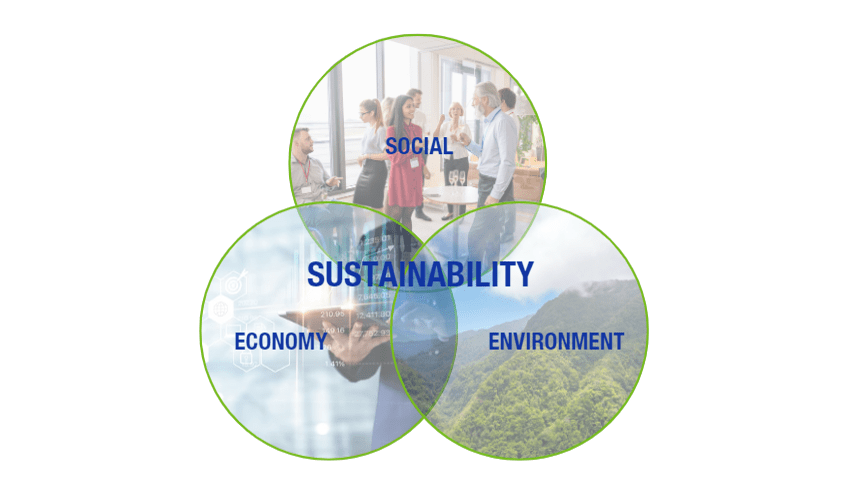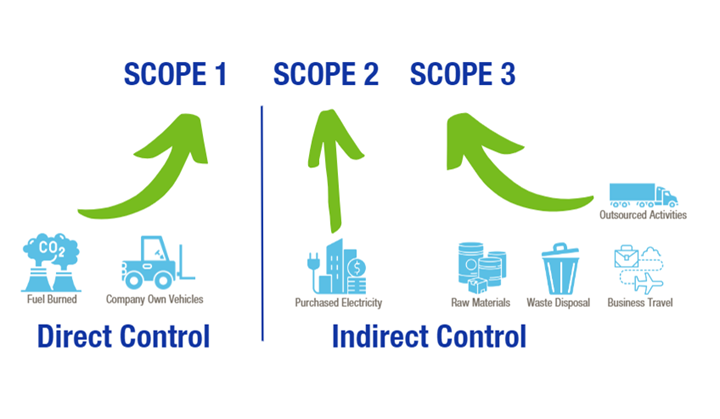
The Glue Talk Blog

What is Sustainability?
The most often quoted definition of “sustainability” comes from the UN World Commission on Environment and Development: “Sustainable development is development that meets the needs of the present without compromising the ability of future generations to meet their own needs.”
Sustainability is a word used throughout the world, and there are three major aspects of sustainability: economy, environment, and social.
Economy:
Economic sustainability is the practice of maintaining the profitability of an organization by considering its environmental, social, and financial impact over time. Businesses must be able to pave their way in society and make a profit, while ensuring they don’t negatively impact the environment or surrounding communities.
Social:
Social sustainability is about identifying and managing business impacts, both positive and negative, on people. The quality of a company’s relationships and engagement with its stakeholders is critical. This includes human rights, fair labor practices, safety, diversity, equity, work-life balance, empowerment, community engagement, and volunteerism. Though social sustainability issues are not easily quantifiable or measurable, they can be easier to identify.
Environmental:
Environmental sustainability is the responsibility to conserve natural resources and protect global ecosystems to support health and wellbeing, now and in the future. It involves the conservation of land, freshwater, oceans, forests, and air.
The different scopes of Greenhouse Gas Emissions (GHG)
At H.B. Fuller, we continuously work on the three important aspects of sustainability. Today, there is a huge focus on environmental sustainability, due to the consequences of climate change.
The need to improve environmental sustainability has never been greater and the expectations of achieving positive change are increasing, especially in reducing the carbon footprint of our activities. Carbon footprint is the total amount of greenhouse gases (GHG) that are generated directly and indirectly by an individual, organization, or product.
The GHG Protocol Corporate Standard classifies a company’s GHG emissions into three ‘scopes’:
- Scope 1 Emissions are direct emissions from all owned or controlled sources.
- Scope 2 Emissions are indirect emissions from the generation of purchased energy, such as used to generate steam, heating or cooling and are a result of the organization’s energy use.
- Scope 3 Emissions are all indirect emissions (not included in scope 2) that occur in the value chain of the reporting company, including both upstream and downstream emissions.

How do adhesives for hygiene articles enable a reduction in Scope 3 GHG?
Though adhesives make up only a small percentage of bonded hygiene articles, they can often be a part of the solutions to drive sustainability progress.
Adhesives play a critical role in bonding multiple components together in a disposable hygiene article, and innovations in the adhesive industry have enabled environmental improvements, such as achieving significant reduction of the overall diaper thickness/weight, to reduced add-on and energy spent on the adhesives themselves.
Adhesives with lower application temperature:
- Are applied at 130°C to 140°C, typically 25% lower than traditional hot melt adhesives.
- Reduce the energy required to heat the adhesive application equipment and contributes to lowering Scope 2 emissions, while improving operator safety.
- Enable the use of thinner materials, which means reduced materials used per item, reduced waste, reduced logistics requirements, and a smaller overall Scope 3 footprint.
Adhesives with improved mileage:
- Offer high performance bonding at low add-on levels, reducing the quantity of adhesive used and enabling cost savings for the manufacturer of absorbent hygiene products.
- Enable Scope 3 improvements through reductions in transportation and raw material resources.
Adhesives enabling thinner articles:
- Enable hygiene producers to implement thinner diaper designs, achieving reduced waste and logistics requirements, via core adhesives with enhanced wet core integrity.
- Can help save on overall materials required, while maintaining core stability and reducing their Scope 3 carbon footprint.
Adhesives from renewable feedstocks:
- Have a lower carbon footprint, compared to traditional standard adhesives, helping producers to reduce their Scope 3 emissions
We are committed to driving measurable improvements in our own carbon footprint to ensure that we are on the right path. We follow industry best practices and continually measure our impact. The world is moving toward eco-oriented innovations, and H.B. Fuller is focused on supporting our customers’ businesses and helping them achieve their sustainable goals. At H.B. Fuller, we are dedicated to finding solutions that make our planet a healthier and safer place. Contact us to learn more.
Blog Categories
Archive
- 2024
- 2023
-
2022
- February (4)
- March (3)
- April (1)
- May (2)
- June (5)
-
August (6)
- Beverage Labeling Market In Africa: A Huge Potenial
- H.B. Fuller’s Glue House: Scavenger Hunt
- Increasing Global Aging Population: Impacts and Challenges
- Innovations and Key Challenges in Sustainable Disposable Absorbent Hygiene Products
- Supporting Racial Equity in Our Community
- Top 5 Reasons to Invest in H.B. Fuller
- September (4)
- November (2)
- December (2)
-
2021
- January (3)
-
February (7)
- Celebrating Exceptional Service During COVID-19 Complications
- Cyanoacrylates: What They Are and What They Do
- Innovative two-shot bookbinding adhesive
- Make a Difference 2020
- Problem Solving: Paper straws in drinking beverages
- Stronger straws
- Substances of Interest in Disposable Absorbent Hygiene Products
- March (4)
- April (4)
- May (4)
- June (5)
- July (2)
- August (5)
- September (2)
- October (1)
- November (3)
- December (2)
-
2020
- January (4)
- February (2)
- March (3)
- April (4)
- May (3)
-
June (7)
- Community Support in the Era of Coronavirus
- Employee Creates Face Shields with 3D Printer
- Improved Packaging Integrity and Greater Customer Satisfaction
- Liquid-Resistant Paper Straws
- What is a Sealant
- What Is the Future of Commercial Disinfectants
- Winning over consumers with e-commerce packaging solutions
-
July (6)
- Employees Take Action to be Part of Healing and Growth
- Gain a competitive advantage with packaging adhesive solutions
- HB Fuller Company Foundations Commitment to Communities
- Packaging Solutions for the South African Agriculture Market
- Supporting Organizations That Provide STEM Education for Youth
- Where Does Sustainability Stand Amid COVID-19
- August (3)
- September (2)
- October (4)
- November (2)
- December (4)
